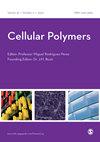Theoretical modeling of longitudinal piezoelectric characteristic for cellular polymers
IF 1.3
4区 医学
Q4 MATERIALS SCIENCE, BIOMATERIALS
引用次数: 5
Abstract
Efficient energy harvesting is a difficult challenge that consists in the development of systems allowing charging autonomous and low-power devices. In addition to traditional piezoelectric polymers, mono-crystals, and ceramics, cellular electrets offer consistent solutions by converting wasted vibration energy from the environment to usable electrical energy. This paper presents an electromechanical model to study the energy harvesting capability of cellular polymers. The theoretical study models the response of these materials to investigate the effect of different parameters on the piezoelectric coefficient d33, particularly. The model considers the percentage of porosity, surface charge density in each polymer–gas surface, the properties of the polymer matrix and the gas encapsulated in the pores, and the Young’s modulus of the porous film. For poly(ethylene-co-vinyl acetate), the results showed that the piezoelectric performance of the film declines with the increase of the film thickness. However, the variation of the d33 as a function of the percentage of porosity is exponential and can achieve 4.24 pC/N for a porosity of 80%. Compared to a previously published experiment, the theoretical results have proven a good agreement with only 3.3% error.多孔聚合物纵向压电特性的理论建模
有效的能量收集是一项艰巨的挑战,包括开发允许自动充电和低功耗设备的系统。除了传统的压电聚合物、单晶和陶瓷外,细胞驻极体通过将环境中浪费的振动能量转化为可用的电能,提供了一致的解决方案。本文提出了一种用于研究细胞聚合物能量收集能力的机电模型。理论研究对这些材料的响应进行了建模,重点研究了不同参数对压电系数d33的影响。该模型考虑了孔隙率百分比、每个聚合物-气体表面的表面电荷密度、聚合物基质和孔隙中封装的气体的性质以及多孔膜的杨氏模量。对于聚醋酸乙烯-乙烯基薄膜,随着薄膜厚度的增加,薄膜的压电性能下降。然而,d33作为孔隙率百分比的函数的变化是指数的,当孔隙率为80%时,d33可以达到4.24 pC/N。与先前发表的实验结果相比,理论结果具有良好的一致性,误差仅为3.3%。
本文章由计算机程序翻译,如有差异,请以英文原文为准。
求助全文
约1分钟内获得全文
求助全文
来源期刊

Cellular Polymers
工程技术-材料科学:生物材料
CiteScore
3.10
自引率
0.00%
发文量
9
审稿时长
3 months
期刊介绍:
Cellular Polymers is concerned primarily with the science of foamed materials, the technology and state of the art for processing and fabricating, the engineering techniques and principles of the machines used to produce them economically, and their applications in varied and wide ranging uses where they are making an increasingly valuable contribution.
Potential problems for the industry are also covered, including fire performance of materials, CFC-replacement technology, recycling and environmental legislation. Reviews of technical and commercial advances in the manufacturing and application technologies are also included.
Cellular Polymers covers these and other related topics and also pays particular attention to the ways in which the science and technology of cellular polymers is being developed throughout the world.
 求助内容:
求助内容: 应助结果提醒方式:
应助结果提醒方式:


